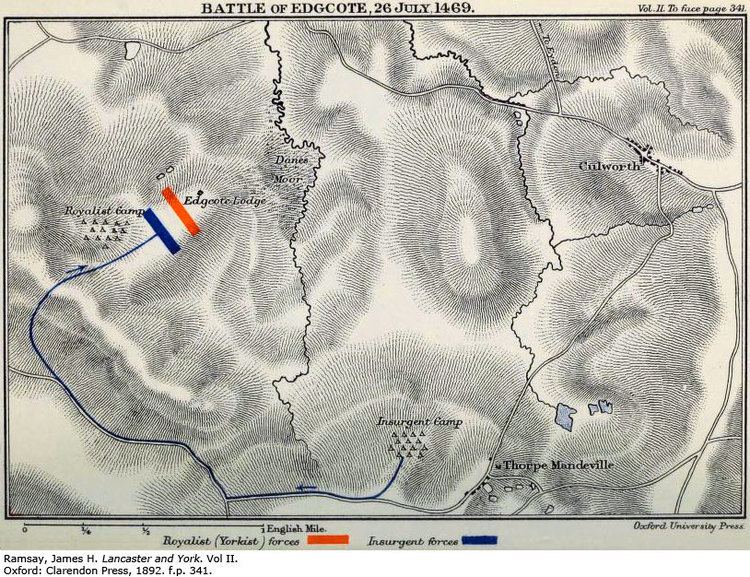Unknown Unknown Date 26 July 1469 | Unknown Unknown Result Rebel victory | |
 | ||
Location Northamptonshire, United Kingdom Combatants House of Lancaster, House of York Similar Wars of the Roses, Battle of Hedgeley Moor, Battle of Losecoat Field, Battle of Hexham, Battle of Ludford Bridge | ||
Battle of edgecote moor 545 year anniversary wars of the roses
The Battle of Edgecote Moor took place 6 miles (9.7 km) north east of Banbury, Oxfordshire, in what is now the civil parish of Chipping Warden and Edgcote, England on 26 July 1469 during the Wars of the Roses. The site of the battle was actually Danes Moor in Northamptonshire, at a crossing of a tributary of the River Cherwell. The battle saw supporters of Richard Neville, Earl of Warwick, defeat the forces of King Edward IV, leading to the king's capitulation soon afterwards.
Contents
- Battle of edgecote moor 545 year anniversary wars of the roses
- The defection of the Earl of Warwick
- The rebellion
- Commemoration re enactments
- References
The defection of the Earl of Warwick
The Earl of Warwick came to be in open rebellion against Edward by 1469. Eight years after the great Yorkists' victory in battle of Towton in which The Kingmaker took crucial part, he and Edward IV fell out. In 1464 Warwick was in the middle of negotiations with pro-Lancastrian France, and he knew that a royal marriage with a French princess could solve their problems. Warwick told Louis XI that Edward would be delighted to marry the French princess, but soon afterwards was informed of the humiliating truth: Edward had secretly been married to Elizabeth Woodville, a commoner, for the past six months. Later on, Elizabeth's brothers and sisters were married off to ladies and nobles of importance, throughout the land. Most of these marriages offended Warwick in some way, and at least one was a direct insult to his family.
Warwick was also angered by Edward's constant refusal to let George, Duke of Clarence, marry Warwick's eldest daughter. Edward claimed hypocritically that Clarence would serve for a diplomatic marriage and none other.
Warwick no longer exercised any control or even influence over his cousin, the King, in political matters. Thoughts turned to rebellion in Warwick's mind, a rebellion in which he already had an ally: the Duke of Clarence, heir to the English throne while the king had no male offspring.
The rebellion
Small rebellions in the North sent the King on a slow march in that direction. With the King's back turned, Warwick's agents spread rumours stating that the King was bastard-born and that Clarence was York's true heir.
In the North, one of Warwick's captains, calling himself Robin of Redesdale (probably a trusted Neville captain, Sir William Conyers), started a new rebellion. When Edward heard of this, he believed the rebellion would easily be put down and mustered only a few of his men. He soon learned that the rebels in fact outnumbered his own small force, and he started a retreat towards Nottingham to gather more recruits. Unfortunately, the King lacked the popularity he once had, and reinforcements were few. Edward decided to wait in Nottingham for the Earls of Pembroke and Devon to arrive with an army from the south.
On 12 July, Warwick and Clarence declared their support for the rebels. On the 18th, Warwick left London at the head of a large army to reinforce the rebels.
The rebels hurried south to meet with Warwick, bypassing the King but nearly colliding with Pembroke and Devon at Edgecote Moor. The two armies became aware of each other on 25 July and joined in battle early in the morning of the 26th. The beginning was a rather one-sided affair as the Earl of Devon and his Welsh archers were some miles away, having stayed the night in a neighbouring village. The rebels attacked across the river forcing Pembroke to retreat and pull his men back some distance. Pembroke was attacked again in his new position, but he put up a brave defence while awaiting Devon. At 1 o'clock the Earl received the news he had been waiting for: Devon was rapidly advancing with all his men. However, at the same time the advance guard of Warwick's army arrived upon the field. Rebel morale was instantly boosted. Seeing Warwick's livery amongst the enemy, Pembroke's men presumed his whole force of expert soldiers was upon them. The royal army broke and fled the field, possibly before Devon could even reinforce them.
The Earl of Pembroke and his brother Sir Richard Herbert were captured and executed the following day. The Earl of Devon suffered a similar fate a few days later.
The rebel dead included Henry Neville (1437-1469), the eldest son and heir of George Neville, 1st Baron Latimer, Sir John Conyers (ca 1420-26 Jul 1469), the son of their general (presumably "Robin of Redesdale") and Sir Oliver Dudley, the youngest son of John Sutton, 1st Baron Dudley.
Following the battle, Richard Woodville, Earl Rivers, father of the Yorkist Queen Elizabeth Woodville, and his second son John were taken prisoners at Chepstow. Following a hasty show trial, they were beheaded at Kenilworth on 12 August 1469
Commemoration & re-enactments
On 12 & 13 September 2009 there was a re-creation of the battle on the actual battlefield, staged by The Medieval Siege Society and the English Tournament Society to commemorate the 540th anniversary.
Following the success of the 2009 commemoration & re-enactment, a second recreation was staged on 11 & 12 September 2010 for the 541st anniversary.
Since 2009, an annual walk of the battlefield and the key sites has taken place on the Sunday closest to the anniversary. The walk pauses at the Trafford Bridge site to lay a wreath remembering all those that lost their lives from both sides. This is organised by The Medieval Siege Society and attended by local residents, and members of the Battlefields Trust.
